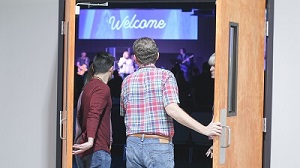Greetings play an important part in human communication. A simple hello can influence the way that you interact with an individual in a personal or business setting.

Saying hello is such a simple act but it’s not always as simple in its impact as it may seem. This greeting is often affected by cultural idiosyncrasies, just like many other aspects of human communication. So, who should say hello first when entering a room?
People in the hospitality industry always greet their guests first, no matter who has newly entered the room. In a business context, the inviting person should start the greeting, and in personal situations, it is the host at the beginning of the event.
Why Say Hello at All?
Some people claim that they couldn’t care less about saying hello or being greeted. However, others think less of someone who doesn’t return their greeting at any time of the day.
Hello and other greetings play an important role in human interactions. Greeting someone shows that you acknowledge their presence.
In offices and other work settings, people say that they feel uncomfortable with helping someone who immediately requests assistance without greeting them first.
Greetings set the tone for meetings, university workshops, and other events.
Greetings also set the tone for your household. The way you greet each other within a family or any type of living arrangement impacts the way that you relate to each other in various daily interactions.
General Situations
In most situations, the person who has entered a room should greet those who are already in the area.
They should not wait for other people to speak. They should greet those who they came and saw there.
For example, if you’re at home and enter a room you should greet any member of your household who you find in the room. Don’t wait for them to acknowledge you. You should show that you recognize their presence in the room.
Similarly, if you enter the break room at your workplace and notice that other people are there, you should greet them. If you go to another common work area and notice that a few people are there, you should greet them.
It’s usually good to enter a room at a moderate pace, instead of rushing in. You can enter and then pause slightly to the right of the entryway. Smile and nod to those who are already in the room, if you don’t want to give a verbal greeting.
Context Can Indicate Who Should Speak First
The context affects who should say hello first. Sometimes there are hierarchies in place that prevent regular rules from being applied. For example in some institutions, it’s expected that individuals in certain roles should wait to be acknowledged. Whether that’s good or bad, that’s how it is within those particular organizations.
This may be peculiar to that organization. It’s important to learn the rules of any organization that you enter so that you can play by them effectively.
Generally, when you enter a room in such an organization and see people of higher rank than you, you should wait to be acknowledged.
Commercial Settings
The rules for commercial settings vary according to the sector. In most government organizations, the customer who enters a room should greet the staff who are there. However, in some industries, customers wait to be acknowledged.
For example, if you enter a restaurant that offers a fine dining experience, you’re usually expected to wait until someone greets you.
This person will also ensure that you are comfortably seated. A waiting area and signage will be provided so that you know what to do in this context.
Generally, people in the hospitality industry always speak before their guests. If you work in any part of the hospitality sector, you shouldn’t wait for your guest to speak to you first. Always greet them as soon as you see them when you enter a room.
Similarly, if they enter a room that you’re in you should greet them while making eye contact.
This applies to any type of room, including a reception area or lobby. Even if you’re not the person who is responsible for that area, you should still greet your guest. Don’t just walk by them without checking that their needs are being met. [1]
Birthday Parties and Other Celebrations
Customs for birthday parties and other celebrations also vary from the general rules. If you are hosting a party, you are expected to greet the people who arrive. If they enter a room that you’re in, you should greet them.
This expectation has a time limit attached.
People who arrive late to the event are usually expected to seek out the host and greet them.
As the host, you’re not expected to stop to greet new arrivals while the party is underway.
Business Meetings
During a business session, the host should be the first person to greet those they see.
For example, if the host is already in a room and someone nee enters, the host should immediately greet that person. They shouldn’t wait for that person to greet those who they see.
Establish Human Connection
Human society has been through lots of changes. Especially in recent years, people have become increasingly physically distant. Some of this has been due to necessity, as a global response to the global pandemic.
Some children are growing up without practice in social norms. They don’t know what’s expected of them when they enter a room. In that case, adults need to model the behaviors which have helped to maintain connections in society.
Even many adults are finding it difficult to reestablish old patterns of behavior. They may recognize a person who is entering a room but they might not respond in the way they did before. They may be wary of another individual, especially a stranger.
Saying hello helps to maintain human connections. Even if you know that another person should have been first to say hello, don’t wait for them to do so if there’s a noticeable pause. Step into that space and attempt to connect with the other individual.
If you’re the first person in the room and someone enters without greeting you, you can still say:
“Hello.”
“Hello. How are you?”
Sources:
[1]: https://www.typsy.com/lessons/how-to-greet-and-seat-guests

Sophie Hammond is a journalist, psychologist, and freelance speechwriter for people in politics and business. She lives on the edge of the Rocky Mountains with her dog and a lifetime supply of books. When she’s not writing, she can be found wandering through nature or journaling at a coffee shop.

